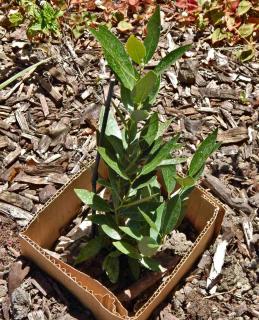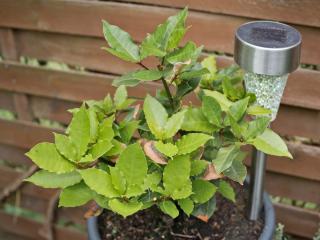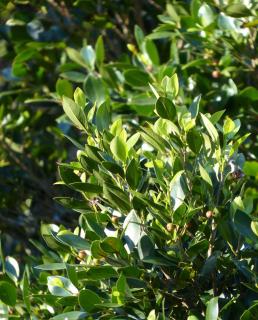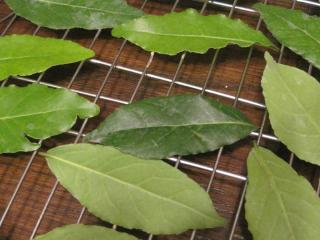

Laurus nobilis, better known as bay laurel, is a must-have for its aromatic leaves.
Laurus nobilis key facts:
Name: Laurus nobilis
Family: Lauraceae
Type: tree
Height: up to 33 feet (10 m)
Exposure: sunny
Soil: all types, well-drained
Hardiness: semi-hardy
Growth: rapid – Foliage: evergreen – Blooming: spring
Common Names: Bay Laurel, True Laurel, Apollo’s Laurel
Laurus nobilis becomes a sizable tree when conditions are favorable. Bay laurel’s claim to fame? Its leaves. They’re tough, narrow, and oval-shaped, often sporting wavy edges. They shine in a rich dark green color, accentuated by yellow-green veins. Most of all, they’re fragrant, giving stews a rich, delicious taste (often together with other herbs).
Come springtime, small pale yellow flowers in star-like shapes appear and later give way to round to ovoid berries. These berries start off green and slowly darken to black. It’s worth noting that bay laurel is a dioecious species; there are male and female plants, and only females bear fruits.
While Laurus nobilis is semi-hardy, it doesn’t appreciate harsh frosts, especially its leaves. If you live in an area with brutal winters, it’s best to grow it in a pot so you can move it to a sheltered spot when it’s chilly.
Our good old friend, Laurus nobilis, isn’t too picky about soil. It’s got to be well-drained though, this one doesn’t like soggy roots! Ideal for this laurel is full sun, in a spot that’s out of the wind. But it can handle a bit of shade if need be.
Want to give your Laurus nobilis the best shot at thriving? Plant it in spring rather than fall. It can handle a bit of drought, but not extreme cold.
In the ground:
 Dig a hole at least 11¾ to 15¾ inches deep (30 to 40 cm). If necessary, put a layer of gravel at the bottom to improve drainage. Adding compost to your garden soil isn’t required, but it does help the tree get settled in.
Dig a hole at least 11¾ to 15¾ inches deep (30 to 40 cm). If necessary, put a layer of gravel at the bottom to improve drainage. Adding compost to your garden soil isn’t required, but it does help the tree get settled in.
After removing the pot, gently pry roots loose without damaging them. Plop the Laurus nobilis in the hole and fill it back up, tamping it down well.
Finish off with a good watering to settle the soil and fill any air pockets. Here, a small carton rim helps concentrate water for the first few months.
Laurus nobilis in a pot:
 As always, the right container is crucial for pot or box cultivation. It should be stable enough to withstand the wind rustling through the leaves, and roomy enough for roots. Most importantly, make sure it has a drainage system.
As always, the right container is crucial for pot or box cultivation. It should be stable enough to withstand the wind rustling through the leaves, and roomy enough for roots. Most importantly, make sure it has a drainage system.
The pot planting process is pretty much the same as for in-ground planting. Just be careful not to block drainage holes when adding the drainage layer.
For the substrate, mix compost, sand, and maybe a bit of perlite.
Your bay laurel needs little care, nearly none. Keep a close eye on watering in the months after planting.
 If, despite your best efforts, your tree freezes, don’t worry. Cut it back near the base after the last frost. It will then grow back from the stump.
If, despite your best efforts, your tree freezes, don’t worry. Cut it back near the base after the last frost. It will then grow back from the stump.
As for trimming, your Laurus nobilis can take it like a champ, be it a small annual snip or a major prune to rejuvenate the plant. You’ll actually find it’s one of the shrubs you have to come back to most often just to keep it under control.
If you have an Apollo’s laurel in a pot, plan on repotting it every 4 to 5 years, to change out the substrate or even the container.
→ Pro tip: while bay laurel is harmless to humans, it’s toxic to decomposer worms and microbes (a bit like eucalyptus and pine needles are). Best not to put its dead leaves in the compost.
Get new bay laurel plants by taking cuttings from semi-hardwood in late summer, or by sowing seeds in fall.
Apollo’s laurel doesn’t have any major pests. However, it can sometimes be targeted by scale insects or bay suckers, which cause discoloration and distortion of the leaves.
As for diseases, downy mildew is the main infection to keep an eye on, even though it’s quite rare.
No surprise here, when we talk about bay laurel, we think of cooking first. However, whether in infusion or essential oil form, the virtues of Laurus nobilis can help with health issues, particularly rheumatism, digestion problems, or stomatitis (inflammation of the mouth lining).
Watch out, though! Laurus nobilis essential oil can cause skin allergic reactions. Also, internal use should only be under medical prescription.
 To fully reap the benefits of the Laurus nobilis, it’s recommended to harvest leaves as you need them.
To fully reap the benefits of the Laurus nobilis, it’s recommended to harvest leaves as you need them.
That being said, you can absolutely store the leaves for later use. All you need to do is dry the branches in a well-ventilated area.
Once dried, keep in an airtight jar. Bay laurel leaves can keep for several years.